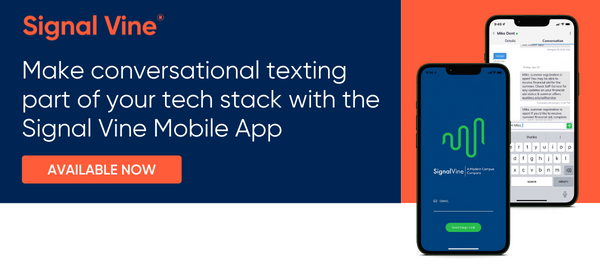Published on
Keep in Touch: How to Increase Student Engagement and Retention Through Text

Student engagement and retention strategies must keep up with modern student needs. Reaching them through the devices they carry daily—their phones—can help ensure they see the right information at the right time and boost student retention year after year.
The EvoLLLution (Evo): What impact does automated texting have on student success?
Kevin Li (KL): We have done AB testing, a sort of randomized controlled trial evaluation, to see how students being texted, or nudged, versus those in a control group respond to see how nudging fairs for students. After one semester, 73% of the students being nudged return to college the following semester, compared to only 70% of the students in the control group. In one semester, we see a retention gain of about 3%. After three more semesters of nudging, we see the gap get larger. The students being nudged continued to return at a rate of 47% after three semesters, compared to 38% of the students in the control group. First-generation students who were nudged have consistently returned at a rate 3-4% higher than the students who were not nudged. Among the students eligible to graduate, 10% of the texted students finished compared to 6% in the control group.
We also saw significant gains in diversity, with 65% of the nudged Latinx students re-enrolling for spring, compared to only 49% who re-enrolled after unsubscribing from the program.
I also want to highlight the fact that this is not just a program that uses texting to remind of upcoming finals or due dates. The automated text is only a means in a technology. We partnered with Persistence Plus, which combines AI chatbot and behavioral science to drive greater retention and completion. So, nudges really came from the field of behavioral economics and psychology. They are essentially indirect suggestions that gently steer the individual to a desired action. For example, placing the bananas at eye-level at a grocery store is a nudge. In a hotel room, when they put a card next to the towels asking to re-use them to save water and a message like “80% of our guests use their towels more than once,” that’s a nudge and a form of behavioral science.
We also borrow a lot of the latest social psychological research and theories such as growth mindset and value affirmations to drive a sense of belonging and allow students to develop a more persistent mindset for college. We also use our framing, psychological interventions to normalize challenges associated with the college journey. Often, when students face challenges, they feel that they may not be intelligent enough or have the capacity to stay in college, but the reality is that we will all face challenges sometime in college, so we want to normalize them, so students become more persistent over time.
Evo: Why did the team focus specifically on improving engagement for first-generation students and adult learners?
KL: After looking at our internal data and really examining the institutional equity gaps, we detected that TRiO programs are very effective but so small. They cannot serve such a large volume of first-generation students. So, they need a different support system. We also know that we have a sizeable adult student population, the majority of which attends part time. Prior to implementing the behavioral nudge program, only one third of the adult student population was persisting to the next fall. Based on this gap in equity and looking at internal data, we feel that the first generation students and older adult students may need that extra support such as the behavioral nudge program.
Evo: What sorts of value affirmations were sent to students?
KL: Through a text, we asked students what values are most important to them, then asked them to explain why. It kind of mirrored an experiment conducted by Stanford social psychologists. They typically offer a list of 15 values, students circle two or three and write about why these values are so important to them. Just that experiment led to longer-term retention, completion and enhanced academic outcomes. I think the theory states that when folks reflect on the values most important to them, they develop a more cohesive sense of self. Thus, they’re less likely to be influenced by challenges or difficulty.
Evo: Is there a tipping point, where after a certain amount of nudges, your team found that they were no longer effective?
KL: Yes. We very much care about the frequency of our messages. If we text 20 times a week, students may think it’s just too much. So, we want to be mindful. We actually sent out two types of texts. We remind them of key dates during the semester. For example, the last day to withdraw or upcoming finals. Those are based on the critical dates within the semester schedule. But we also send out many other text messages with the intention of really driving a more positive mindset and behavior. For example, we use the principle of social norm to let student know that many of their classmates are getting tutoring help and ask if they would consider making an appointment with a tutor themselves. We are seeing more productive help-seeking behavior because of that type of nudging.
Evo: Beyond reminders and affirmations, where can this combination of tech and strategy for student engagement be used in the future?
KL: From a higher ed professional perspective, it’d be really great if more of us were doing randomized control trials, as we have done, to accumulate more evidence and strengthen the science of nudging. I believe that could be the next frontier. When more institutions are aware that this is not just a communication tool but that there’s a lot of science behind it, they will come on board and follow the same approach to benefit more students at scale and in a more cost-effective manner. In addition to nudging students toward certain behaviors, texting can also become a means for us to learn more about their perspective, their voices and their needs. So many of our messages really sought to start conversations about students’ goals and motivations.
During the pandemic, a lot has shifted. Colleges quickly went virtual, but we had already established a caring channel with our texting. We continued to check on students, taking the pulse of their evolving needs. We asked whether they’re okay, gauged their technology needs as they pivoted to remote learning, asked what challenges they’re facing. We took that opportunity as collecting a lot of input and getting a sense of what students need and what we need to do to support them. Being able to let the student’s voice to come through is incredibly helpful.
Over time, our messages evolve. Right now, we are focusing on helping them with stress and anxiety, meeting public health requirements and acclimating back to campus. We’re also leveraging programs to reach out to formerly enrolled students who have become disengaged during the pandemic. We are trying to offer help and enable them to compete their education or find a new career by continuing to reach out to them. Because the labor market is so hot right now, many high school graduates would rather pick up a job that pays quite well rather than accumulating debt by attending college. What do we do about that? We need to encourage students to think long term and really consider the opportunity cost of not attending college. So, we are shifting our focus to some of the new challenges our students are facing.
Evo: Why use texting instead of more traditional means of communication like email?
KL: Students have preferred modes of communication. Our own internal statistics stated that about 50% students prefer email. But the younger generations perhaps, up to 30%, actually preferred communications via texting. As educators, we need go with the demographics and really meet them where they are. If we want them to receive information from us or communicate with us via texts, we have to adapt to their preferences.
Evo: Is there anything else that administrators should know about texting services?
KL: Many students are really engaging, for example, replying to the chat box and expressing appreciation. One student texted back: “A person does not realize what a little encouragement and reminder can do.” And other students said, “I like that it recommends resources I did not know the college offered, and I think motivational texts and advice help a ton. It wasn’t pushy either.” So, we are getting a lot of positive feedback from students on the platform and using the program.

This interview was edited for length and clarity.
Author Perspective: Administrator



